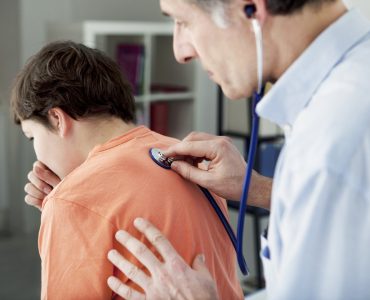Diagnosis of Muscular Dystrophy
The condition of Muscular Dystrophy cannot be diagnosed unless there is a high probability of a baby boy taking over the Duchenne Muscular Dystrophy from the parents. If a child has been afflicted by the muscular dystrophy, it will be noticed that he/she has problems in walking, getting up, standing and climbing the steps. They tend to fall down frequently, and use their knees and thighs as a support when they want to get up off the ground.
Duchenne and Becker Muscular Dystrophy are diagnosed by examining the child’s style of walking and his general posture. The inner back of the child may be inwardly curved (known as lordosis or sway back). Alternatively, the spine may be outwardly curved (known as scoliosis). The leg muscles, like the calf may look huge compared to the other muscles that look feeble. Several tests are performed to confirm the diagnosis of Muscular dystrophy. However, initially it is hard to detect the defect; therefore a blood test is done to check the possibility of Muscular Dystrophy.
Blood Test
The blood test is done to check the level of a chemical known as ceratine phosphokinase, which exists in the muscle fibres and also in a small quantity in the blood. In the body of the people who have been afflicted by Duchenne or Becker Muscular dystrophy, this chemical seeps out of the muscle fibres into the blood.
Other tests
If the amount of ceratine phosphokinase is not normal, a biopsy is conducted. Biopsy refers to taking a tiny sample of a muscle and testing it for dystrophin. These days a DNA test of the faulty gene is carried out to diagnose muscular dystrophy. Also, an EMG (electromyography) test may be performed to diagnose the condition. To test the activity of the heart, an endiogram and an ultrasound may be performed.
Treatment of Muscular Dystrophy
There is no permanent cure of Muscular Dystrophy. However there is a possibility of controlling the symptoms of Myotonic dystrophy. Some of the common treatments of the condition are:
Regular Exercise
Physiotherapy
Physical aids
Fitting a pacemaker
Surgery
Support groups and other organisations can help the person to understand that he/she can overcome the situation by following the prescribed treatments.
Preventing Muscular Dystrophy
For those parents who have a medical history of Muscular Dystrophy, DNA testing and genetic counselling can be of great help in detecting whether one or both parents have a defective gene and knowing the risk of the condition being passed on to their children.
Complications of Muscular Dystrophy
Muscular Dystrophy can create complications such as:
Pneumonia and respiratory infections or respiratory failure
Obesity (excessive weight gain)
Osteoporosis (feeble and brittle bones)
Lordosis, scoliosis and various other skeletal abnormalities
Joint contractures (losing the range of mobility in the joints)
Progressive, permanent disability with reducing mobility
Difficulty in learning and grasping
Arrhythmias (improper heart beats), heart failure or cardiomyopathy











